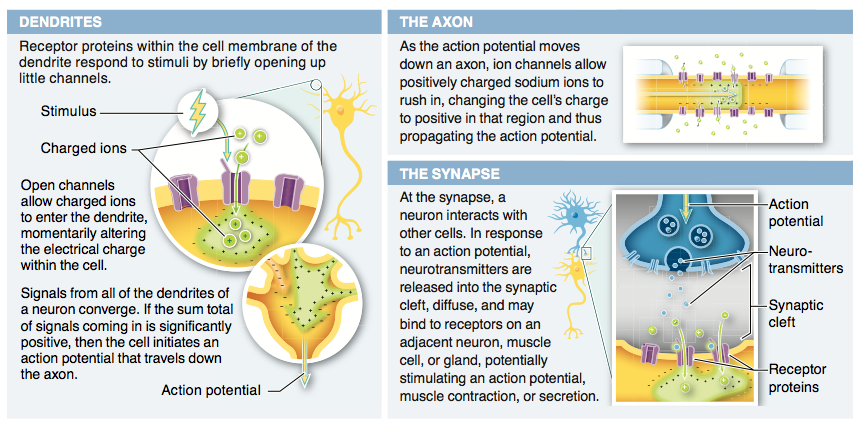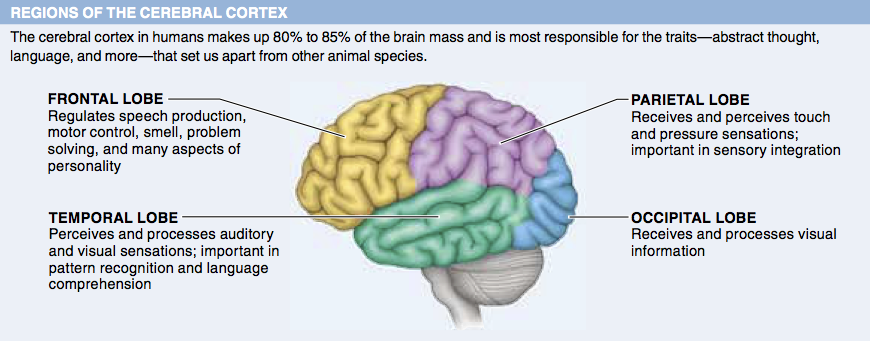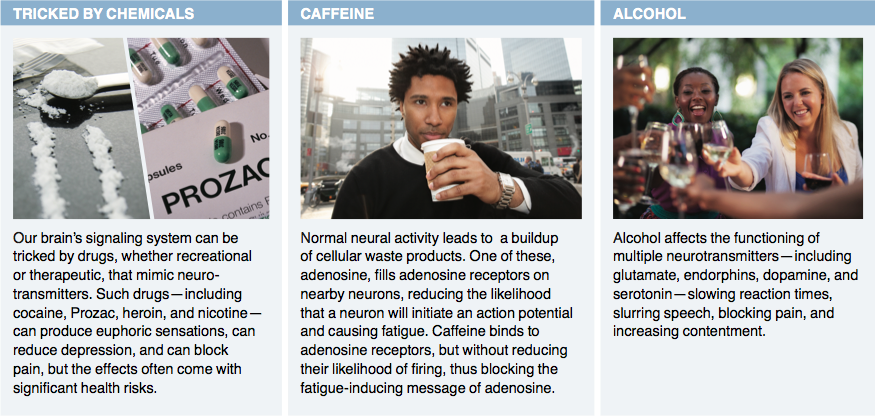Chapter 23. Chapter 23: Nervous and Motor Systems
Review & Rehearse
Review & Rehearse
true
true
You must read each slide, and complete any questions on the slide, in sequence.

Instructions
Review the visual summaries and answer the essay questions below.
Make sure to enter a brief response that completely answers each question and explains your reasoning. When you click "Submit," you will be provided instant feedback, allowing you to check if your response is correct.
(This activity contains 20 total essay questions. Each new question will be revealed once you complete the preceding question.)
Question 23.1


Without the sensation of pain, it is possible to be injured and not know that the injury has occurred, meaning that an injury—from minor to serious or even life-threatening—might not produce the normal reaction to take care of the injured body part and prevent future injury.
Question 23.2

Neurons (nerve cells) are a type of cell specialized for generating and conducting electrical impulses. Each neuron is made up of dendrites, a cell body, and an axon. Glial cells support, protect, and insulate neurons. There are about nine times as many glial cells as neurons in the human brain. Glial cells regularly divide, whereas neurons do not.
Question 23.3


Damage to the spine directly impairs the central nervous system (which consists of the spinal cord and the brain).
Question 23.4


Dendrites of motor neurons and interneurons generally connect with and receive signals from other neurons. Dendrites of sensory neurons are modified to respond to a specific external stimulus (through a sensory receptor), such as touch, sound, light, or a chemical.
Question 23.5
9shf3vSpz3OjdVQBCSAssfp/6TqMErEkSBxoaiIp8S0J0Ix7QVPTUUINVPEi3H4rdxIP59osR+HGR92nTXHbxx1C12pJ/CoXhzYDNXJO8AxDpLJFxglltrss5KCySrUnEVGpINsDS4eW9RtVhiReTnXbNb4Fh8MwB5UlJ2xj5MUUK9Ln2rEyKgXV8iTAfnaGV3dFVw==The myelin sheath prevents weakening of the action potential as it travels along an axon. Without the myelin sheath, the action potential would dissipate and lose its ability to influence—that is, to pass on a nerve impulse to—neighboring cells, including other neurons and muscle cells.
Question 23.6
r0Eh2oBNy8c2p/WmUSoZxWVbt0NZSItBnRsU6fjc3B9ttpWPwqocpFIGbQL1oJOLx+0RQQ2Ydt2aENGoCNguUSDZ+ycbviEmbtzXXTlPlh9+W5VLtSM9gSUt/XY=The option to not propagate a signal is the nervous system’s way of controlling which signals get through and thus require a response. This filtering property prevents flooding of the brain with an overwhelming amount of sensory information.
Question 23.7
k7rxD23Rxks09NcZJjxJu9VY3nlh1/Hn8YFHwRx6nT3jChZ9VuO+cMv4W2kKJjs9wyl3mkILIbGXpIHg6UZBq/TQJCs5lDfrXUlxshPHQzSN+2mOQ+l62LBBx3gk4cKCIOoDcsWnm+M=When acetylcholine binding is blocked at the receptor site, this neurotransmitter cannot bind to muscle cells and the cells are unable to contract.
Question 23.8


Among different species, evolutionary changes have resulted in differences in the relative amount of brain structure dedicated to various abilities and behaviors. Humans have more neurons devoted to abstract thought, perception, and language than do other species. As decisions to be made get increasingly complex, the brain circuitry required becomes more complex, so the brain and head become more prominent structures.
Question 23.9
wyOuyi+FWeJSYuK/JiRY3oQkzjf9QPSMcujX80O6Z3t+hLZg8qCTcgheyQlL+N34+qL3EQYeWKcR/DZHDAfswgxZbS/W/T0YMWAuXUTJ+dk+gdH0Sugar substitutes have a chemical structure similar to that of sugar and can stimulate the chemoreceptors normally stimulated by sugar, and thus are perceived by the brain as sugar.
Question 23.10
Qc7tgSsYAesE2Ly7SojOwCahQKT+hFJI9JkJl+OCrJd4HADxd4VwWBVNS4e5tl3B3ebdrp7/N4m+cgjUrsN+gstgi4MDnRvFc8KdrQ==In humans, the senses of smell and taste are closely connected because the same air circulates around the mouth, throat, and nasal passages.
Question 23.11
j+S6Z4hWSPmxJPszlPVQVWLDm1nW/vQtGnN+HxGOF/IlrO3u1ca7bWKvTjTvSXL75TZbd3yTwENX89tOq0a4GCX/TMYV8TkLyzaMdLnGnVoyq8W6D6RVUxc1mS/XpnfCVlYPOpiQ/zrfctVPSome insects have a broader range of light-sensing pigments in their photoreceptor cells than do humans. These light-sensing pigments allow them to perceive wavelengths of light in the ultraviolet region of the spectrum.
Question 23.12
KuwHNOcaIrHewSjH7RIFGJHNHji5EKzdU2hN3XAK4oZ1zjB5hNmffiVvsH+y3SNxzNMYbBe3tHcDl5wMThe fluid in the canals of the inner ear acts as a motion detector, telling the body about its orientation in space and its direction and speed of movement.
Question 23.13
XTjJ6P07VU7drcP5bZapBHO1/L6ETB/7g+ciWuaZdEM6/yFuVxNbOa9UdOooFKuNTuz3dA8MYTmUATN4mH/QVXcVtypXv/nN/f/bRE0vJgtVePWOy0/7CfKfVOVuNI/UNGrCj7IUQUpm3zXoqfdp3QCrr+KwyJr82z6b9H1K3gGl1LyJejy0KuG5LLagYgJtThe five senses are taste, smell, vision, hearing, and touch. Chemoreceptor cells are stimulated by chemicals in food and produce taste. Smell receptors are dendrites with tiny hair-like projections covered with chemoreceptors and detect odors. Photoreceptor cells have light-sensitive molecules embedded in their membranes and facilitate vision. Hearing occurs when sound waves stimulate mechanoreceptors—specialized receptors that respond to mechanical pressure—and initiate an action potential that passes along a series of neurons to the brain. The sense of touch is generated through mechanoreceptors sensitive to pressure, thermoreceptors sensitive to temperature, and pain receptors sensitive to pain.
Question 23.14
WX9m5bgNWCa3cCPwv2KLA5Tq1Q7S2uBjbhyxbxAwXwc3Ki2a2EdNhPaX7v7/bN7A7+4B79XnkRS9mplNC2SA2ZKakFw62ocOa+U7hglWbGSEPYoyNqvREFVZ3RU4TX4xYYlYp8g2o7saT+6wMI6pGWm4PnianxISo5P7i9rCUsGYkSqXWADyYnjTPs/pRzcOgWcWktgrZt+71AaBv+4txmHQsMNE2APWVQNLiXDKr+FqggHDYMbFLbiGUsa5lFmQswLlhPIst9nTmVA0nJQ7Wngn/8s=Animal senses in addition to the five human senses include those that perceive and respond to balance and motion, electricity, magnetism, and heat production in the animal’s environment. For example, animals that detect magnetism, such as the beluga whale, can use this sense to navigate. In marine animals that detect electricity, such as the shark, the ability to sense changes in electrical charge helps them to sense the muscle contractions of nearby prey.
Question 23.15


Myofibrils are organelles that shorten when they contract. They contain repeating units called sarcomeres, where the contractions take place. Sarcomeres are composed of long filaments, overlapping and parallel to each other, of two types: thin (actin) and thick (myosin). The sarcomere shortens with the making and breaking of links between actin and myosin: (a) a link between a myosin filament and an actin filament is broken, (b) energy released from ATP changes the myosin into a higher-energy shape, (c) the myosin reaches farther down the actin filament and reattaches, and (d) the myosin snaps back to its original shape, pulling on the actin filament and shortening the sarcomere and thus the muscle fiber.
Question 23.16

The skeletal system (a) provides shape and structure, and (b) enables movement through the action of muscles connected to the bones.
Question 23.17


The forebrain is the largest region of the brain and is responsible for most higher thought, including perception, memory, language, intelligence, and personality.
Question 23.18


The amygdala and hippocampus are responsible for storing memory. The amygdala seems to associate emotional feelings and sensory input with memories so that certain smells or tastes elicit memories. Some evidence for the role of the hippocampus comes from the study of birds: black-capped chickadees store large numbers of nuts for the winter; researchers found that the birds’ hippocampus is significantly larger in the fall, when the birds must remember their nut-stash locations, than in the spring, when they no longer need to rely on stored nuts for food.
Question 23.19


Serotonin remaining in the synaptic cleft will continue to stimulate the postsynaptic cell and cause activity in the pleasure centers of the brain, elevating mood.
Question 23.20
iVqkjMLzudKBjGfUq8lJiwTqZLHMxQldQ9mQMHmXSG+gK23kA/W2pNICv113F+BIVu4T+FuHUwGj5XP03HxtUQ==Caffeine binds to receptors intended for the binding of fatigue-inducing adenosine, so we feel alert rather than tired.
Activity results are being submitted...